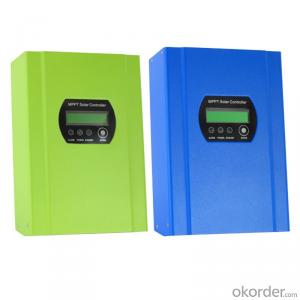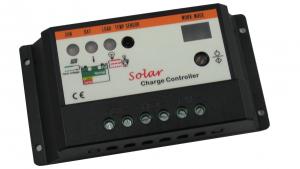Leading Solar Controllers Master100A MPPT Solar Regulator, 12V 24V 36V 48V Charge Controller 4000W
- Loading Port:
- China main port
- Payment Terms:
- TT OR LC
- Min Order Qty:
- 10 unit
- Supply Capability:
- 9999 unit/month
OKorder Service Pledge
OKorder Financial Service
You Might Also Like
High efficient MPPT 48v 100a solar charger controller

Products Advantages
1. MPPT charge mode,conversion efficiency up to 99%;
2. Maximum PV input is DC 150V;
3. Support all kind of batteries, non-normal type can be set on PC software;
4. Three stage charge mode: fast charge,constant charge,floating charge);
5. With temperature sensor;
6. Anderson connection port, avoide reverse connection;
7. RS232 and LAN communication port, free PC software;
8. Intelligent design,the device can be upgraded online;
9. The devices can suffer the temperature not less than 105°C;
10. Perfect protection:input lowvoltage,input overvoltage,input polarity reversal,
output over voltage,short-circuit over temperature;
11. Unlimited parallel;
12. 5 discharge mode;
13. LCD and LED show all kinds of parameter;
14. CE,ROHS,FCC certifications approved.The device also can support to pass the other certifications;
15. 2 years warranty and 3~10 years extended warranty service also can be provided.
Connection Diagram



Upper PC Software

Test Software

Parameter
MPPT controller Model: Master1-80A/100A Series | 80A | 100A | |
Charge Mode | MPPT(Maximum Power Point Tracking) | ||
Charge Method | 3 stages: fast charge(MPPT),constant voltage, floating charge | ||
System Type | DC12V/24V/36V/48V | Automatic recognition | |
Conversion Efficiency | DC12V/24V/36V/48V | 96.5% ~99% | |
PV Modules Utilization Rate | DC12V/24V/36V/48V | ≥99% | |
PV Input Characteristics | |||
MPPT Working Voltage and Range | 12V system | DC22V~DC150V | |
24V system | DC34V~DC150V | ||
36V system | DC50V~DC150V | ||
48V system | DC60V~DC150V | ||
Input Over voltage Protection Point | DC12V/24V/36V/48V | DC150V | |
Rate charge current | DC12V/24V/36V/48V | 80A | 100A |
Max. PV Power | 12V system | 960W | 1200W |
24V system | 1920W | 2400W | |
36V system | 2880W | 3600W | |
48V system | 3840W | 4800W | |
Charge characteristic | |||
Selectable Battery Types (Default type is GEL battery) | DC12V/24V/36V/48V | Sealed lead acid, vented Gel, NiCd battery (Other types of the batteries also can be defined) | |
Temperature Compensation | DC12V/24V/36V/48V | 14.2V-(The highest temperature-25℃)*0.3 | |
Discharge characteristic | |||
Setting Control | Controller or PC software | ||
Max discharge current | DC12V/24V/36V/48V | 100A | |
Output control mode | Double-time control, ON/OFF mode, PV voltage control, PV&Time control | ||
Physical | |||
Communication Port | RS232 and LAN | ||
Measurement D*W*H (mm) | 420*280*102 | ||
N.G(kg) | 7.5 | ||
G.N(kg) | 8.5 | ||
Color | Blue, Green, White (optional) or OEM | ||
Environment | |||
Humidity | 0~90%RH ( no condense) | ||
Altitude | 0~3000m | ||
Operating Temperature | -20℃ ~ +40℃ | ||
Storage Temperature | -40℃ ~ +75℃ | ||
Atmospheric Pressure | 70~106kPa | ||
Certifications |

F&Q: |
Q1. How to ensure and monitor the products quality?
A1: We have established a perfect Quality Management System, In strict
accordance with ISO9001: 2008 quality system and ISO14001 environment system for quality assurance management;
Our ISO9001:2008 Quality System certificate encoding: CHIN/TW/QMS/00119;
Our ISO14001 Environment System certificate encoding: CHIN/TW/EMS/00028;
Q2. What is the warranty of products?
A2: The warranty period of different products are different; 5 years, 3 years, 2 years, 1 years; More details please refer to the product specification or manual; we will provide free life-long technical support ;
Q3. What is the difference between MPPT&PWM?
A3. MPPT charging mode, peak efficiency up to 99%, saving 30%~60% solar panel than traditional PWM controller.
- Q: Can a solar controller handle power spikes from lightning strikes?
- Yes, a solar controller is designed to handle power spikes from lightning strikes. It acts as a protective measure by regulating and managing the power flow from the solar panels to the batteries, ensuring that any sudden increase in voltage or current caused by lightning strikes does not damage the system.
- Q: Can a solar controller be used with solar-powered remote control systems?
- Yes, a solar controller can be used with solar-powered remote control systems. A solar controller helps regulate the charging and discharging of the batteries in a solar-powered system, ensuring optimal performance and preventing damage. This makes it an essential component in remote control systems that are powered by solar energy.
- Q: How does a solar controller handle shading or partial shading of solar panels?
- A solar controller handles shading or partial shading of solar panels by utilizing a technique called Maximum Power Point Tracking (MPPT). MPPT algorithms continuously monitor the voltage and current output of the solar panels to determine the optimal operating point where the panels can generate the maximum power. When shading occurs, MPPT automatically adjusts the electrical characteristics of the panels to ensure that the shaded portion doesn't drag down the overall performance. This allows the unaffected areas to operate at their maximum potential, mitigating the impact of shading and optimizing the overall solar panel efficiency.
- Q: What is the role of a USB charging port in a solar controller?
- The role of a USB charging port in a solar controller is to provide a convenient and versatile way to charge electronic devices using solar power. It allows users to connect their devices directly to the solar controller, harnessing the energy from the solar panels to charge their devices efficiently and sustainably.
- Q: What is the boost charging mode of a solar controller?
- The boost charging mode of a solar controller is a charging stage that provides a higher voltage to the battery in order to fully charge it. It is typically used when the battery's voltage is low or when it needs a quick recharge to reach its maximum capacity.
- Q: What is the role of a battery voltage sensor in a solar controller?
- The role of a battery voltage sensor in a solar controller is to monitor the voltage level of the battery, ensuring that it remains within safe operating limits. This sensor helps to prevent overcharging or deep discharging of the battery, which can lead to damage or reduced lifespan. By continuously measuring the battery voltage, the solar controller can regulate the charging process and optimize energy flow from the solar panels to the battery, maximizing efficiency and ensuring the battery's longevity.
- Q: Can a solar controller be used with different types of solar panel snow removal systems?
- Yes, a solar controller can be used with different types of solar panel snow removal systems. The solar controller regulates the charging and discharging of the batteries in the system, and it can be configured to work with various snow removal methods such as heated wires, brushes, or automated tilting systems. The controller ensures that the snow removal system operates efficiently and effectively, regardless of the specific type of system being used.
- Q: Can a solar controller be used with solar-powered weather monitoring stations?
- Yes, a solar controller can be used with solar-powered weather monitoring stations. A solar controller is essential for regulating the charging and discharging of batteries in a solar power system. It helps maintain optimal charging levels and protects the batteries from overcharging or deep discharging. Therefore, using a solar controller ensures the efficient and reliable operation of solar-powered weather monitoring stations by effectively managing the power supply.
- Q: Can a solar controller be used in a solar-powered electric scooter charging system?
- Yes, a solar controller can be used in a solar-powered electric scooter charging system. The solar controller plays a crucial role in regulating the flow of electricity from the solar panels to the battery of the electric scooter. It ensures that the charging process is safe and efficient by monitoring and controlling the voltage and current.
- Q: What is the maximum voltage drop allowed between the solar panels and the load?
- The maximum voltage drop that is permissible between the solar panels and the load is determined by several factors, including the specific application, the distance between the panels and the load, and the electrical requirements of the load. To ensure optimum efficiency and performance of the solar power system, it is generally advised to minimize the voltage drop as much as possible. A higher voltage drop can result in power loss, reduced output, and overall decreased effectiveness of the system. For most solar installations, it is commonly accepted to have a maximum voltage drop of approximately 2-3% of the total system voltage. This means that if the solar panels are operating at 100 volts, the maximum voltage drop allowed would be around 2-3 volts. However, it is important to note that specific guidelines and requirements may vary depending on the application and the local electrical codes. Therefore, it is recommended to seek advice from a qualified solar installer or engineer who can evaluate the specific parameters of the system and provide accurate guidance on the maximum voltage drop allowed for that particular setup.
Send your message to us
Leading Solar Controllers Master100A MPPT Solar Regulator, 12V 24V 36V 48V Charge Controller 4000W
- Loading Port:
- China main port
- Payment Terms:
- TT OR LC
- Min Order Qty:
- 10 unit
- Supply Capability:
- 9999 unit/month
OKorder Service Pledge
OKorder Financial Service
Similar products
Hot products
Hot Searches
Related keywords





























